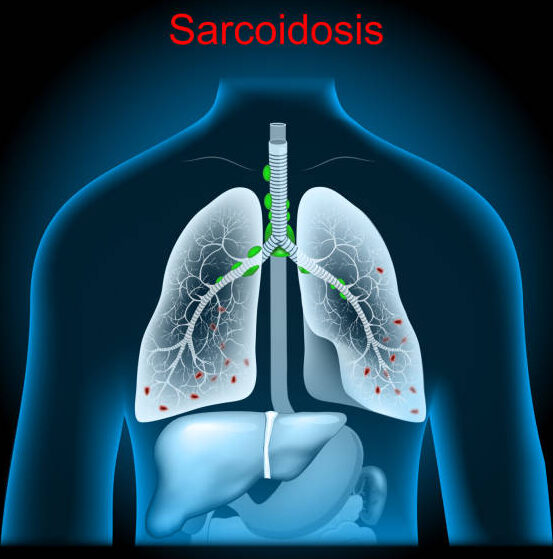Sarcoidosis is a rare yet complex inflammatory condition that occurs when clusters of immune cells form granulomas—patches of swollen tissue that can develop in various organs. While some people with sarcoidosis experience mild symptoms that resolve on their own, others may develop chronic, life-altering, or even life-threatening complications. Understanding the severity of this disease involves examining its symptoms, causes, affected organs, potential complications, and available treatment options.
Understanding Sarcoidosis: What is it?
Sarcoidosis is classified as an inflammatory disease in which the body’s immune system becomes overactive, leading to granuloma formation. These granulomas primarily affect the lungs and lymph nodes but can also develop in the skin, eyes, heart, and nervous system. The condition varies in severity, with some individuals experiencing minimal symptoms and others suffering from severe organ dysfunction.
The exact cause of sarcoidosis remains unknown, but researchers believe it results from an abnormal immune response to an unknown trigger, possibly an infection or environmental exposure. Genetic predisposition may also play a role in determining who develops the disease.
Prevalence and Risk Factors
Sarcoidosis is considered rare, yet it affects an estimated 1.2 million people worldwide. In the United States, between 150,000 and 200,000 individuals are living with the disease, according to the Foundation for Sarcoidosis Research.
Who is at Risk?
- Age and Gender: Sarcoidosis typically affects adults between the ages of 20 and 60, with a slightly higher prevalence among women.
- Ethnicity: African Americans, Scandinavians, and Northern Europeans are more susceptible, with African Americans being nearly three times more likely to develop sarcoidosis than white individuals.
- Genetics: Those with a family history of sarcoidosis are at higher risk.
- Environmental Exposure: Exposure to certain dust, mold, or chemicals may increase susceptibility.
- Autoimmune Conditions: Individuals with other immune-related disorders may be at greater risk.
Signs and Symptoms of Sarcoidosis
Sarcoidosis symptoms depend on the organs affected, and in many cases, they can mimic other diseases. Some individuals may not even realize they have the condition until an incidental imaging test detects granulomas.
Common Symptoms of Sarcoidosis
- Fatigue and general malaise
- Weight loss without trying
- Persistent dry cough (when lungs are affected)
- Shortness of breath or wheezing
- Fever and night sweats
- Swollen lymph nodes
- Skin rashes or reddish bumps, often appearing on the shins
- Blurred vision or eye pain
- Joint pain and stiffness
- Heart palpitations or arrhythmias
Organ-Specific Symptoms
- Pulmonary Sarcoidosis (Lungs): The most common form, leading to chronic cough, lung scarring, and difficulty breathing.
- Cardiac Sarcoidosis (Heart): Can lead to arrhythmias, heart failure, or even sudden cardiac arrest.
- Neurological Sarcoidosis (Nervous System): May cause facial paralysis, seizures, or brain inflammation.
- Ocular Sarcoidosis (Eyes): Results in inflammation, leading to vision problems or blindness.
- Dermatological Sarcoidosis (Skin): Can cause nodules, lesions, or discoloration.
Potential Complications: How Serious Can It Get?
For many people, sarcoidosis is self-limiting, meaning it resolves without long-term damage. However, for others, the disease can become chronic or even life-threatening.
1. Pulmonary Fibrosis (Scarring of the Lungs)
One of the most severe complications of sarcoidosis is pulmonary fibrosis, a condition in which lung tissue becomes scarred, making it difficult to breathe. In severe cases, this can lead to respiratory failure.
2. Cardiac Sarcoidosis (Heart Involvement)
Sarcoidosis affecting the heart can result in abnormal heart rhythms (arrhythmias), heart block, or cardiomyopathy, which weakens the heart muscle and can lead to heart failure. In rare cases, it can cause sudden cardiac arrest.
3. Neurosarcoidosis (Nervous System Involvement)
When sarcoidosis affects the nervous system, it can cause meningitis-like symptoms, facial nerve paralysis (Bell’s palsy), or severe neurological impairments. Seizures and strokes are also potential complications.
4. Chronic Kidney Disease
Sarcoidosis can lead to high calcium levels in the blood (hypercalcemia), which may cause kidney stones or, in severe cases, kidney failure.
5. Vision Loss
Ocular sarcoidosis can cause chronic eye inflammation (uveitis), which, if left untreated, can result in blindness.
6. Multi-Organ Failure
In the most extreme cases, sarcoidosis can progress to multi-organ failure, particularly if vital organs like the lungs, heart, or kidneys are severely damaged.
How is Sarcoidosis Diagnosed?
Because sarcoidosis symptoms mimic many other conditions, diagnosing the disease can be challenging. A physician may use the following tests:
- Chest X-ray or CT Scan: To detect lung involvement and granulomas.
- Pulmonary Function Tests: To measure lung capacity and function.
- Blood Tests: To check calcium levels and inflammatory markers.
- Biopsy: A tissue sample may be taken from the lungs, skin, or lymph nodes to confirm granuloma formation.
- Electrocardiogram (ECG) or MRI: To assess heart involvement.
- Eye Examination: To check for ocular sarcoidosis.
- Nerve Conduction Studies: If neurological symptoms are present.
Treatment and Management of Sarcoidosis
There is no definitive cure for sarcoidosis, but treatment focuses on managing symptoms and preventing organ damage.
1. Corticosteroids
Prednisone is the most commonly prescribed treatment to reduce inflammation and prevent granulomas from causing permanent damage.
2. Immunosuppressive Medications
In cases where corticosteroids are not effective or cause severe side effects, drugs like methotrexate, azathioprine, or mycophenolate may be used to suppress the immune system.
3. Biologic Therapies
Medications such as tumor necrosis factor-alpha (TNF-alpha) inhibitors (e.g., infliximab) may be used for severe cases.
4. Anti-Inflammatory and Pain Medications
Nonsteroidal anti-inflammatory drugs (NSAIDs) like ibuprofen can help manage pain and inflammation.
5. Oxygen Therapy
For individuals with severe lung involvement, supplemental oxygen may be necessary.
6. Lifestyle Changes
- Healthy Diet: An anti-inflammatory diet rich in fruits, vegetables, and omega-3 fatty acids may help manage symptoms.
- Regular Exercise: Helps maintain lung and heart health.
- Avoiding Triggers: Reducing exposure to environmental pollutants and smoking cessation can prevent flare-ups.
7. Organ Transplantation
In rare cases where sarcoidosis leads to irreversible organ failure, lung or heart transplantation may be the only option.
Living with Sarcoidosis
For some, sarcoidosis is a mild and temporary condition, while for others, it can become a chronic illness that requires long-term medical management. Regular follow-ups with healthcare providers, adherence to treatment plans, and lifestyle modifications can help manage the disease effectively.
Mental health support is also crucial, as chronic illnesses can take an emotional toll. Support groups, counseling, and patient advocacy organizations like the Foundation for Sarcoidosis Research provide valuable resources for those affected.
Sarcoidosis remains a complex and unpredictable condition. While some cases resolve without intervention, others lead to life-threatening complications. Early diagnosis, vigilant monitoring, and appropriate treatment can significantly improve quality of life and outcomes for individuals with sarcoidosis. If you experience unexplained symptoms such as persistent cough, joint pain, or fatigue, consulting a doctor is essential for timely diagnosis and management.







